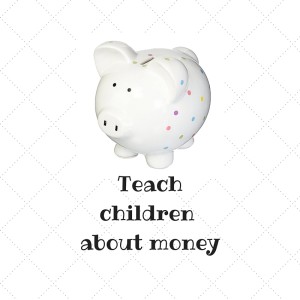When you teach children about money by incorporating it into play times, you provide opportunities for them to practice counting, to use money vocabulary and to work with the terms, more than and fewer than. Learning about money also helps students understand other mathematical concepts such as fractions and decimals in later grades.
Bring in flyers and let students see the numbers beside the pictures of items, using terms such as buy, sell, sale, cost, price, dollars and cents. Talk about saving money and what it means to save up for something.
Start by letting children play with real money and by teaching them the names of the coins. Small group activities such as weighing two different types of coins in balance buckets or building patterns with coins will help children to learn money vocabulary in a natural way.
K – 2 Money Skills
Note that the money used in these activities will vary geographically. Pennies have been phased out here in Canada, so I haver removed them from the posts.
During the kindergarten to grade 2 years the students are working toward:

- comparing the differences between nickels, dimes, and quarters
- correctly using the terms above when naming coins
- learning the value of money, one coin at a time
- start with a nickel, then a dime, then a quarter
- provide plenty of opportunities for children to grasp the value of one coin before working with another
- learning to count by ones, fives, and tens
- applying money to real-life situations such as buying small toys
- applying other mathematical concepts such as counting, adding, patterning, and graphing to nickels, dimes, and quarters
- solving simple problems requiring them to count and add money
- learning the differences between needs, wants, and wishes
Use real coins to make patterns
 Teach children about money by using real money to create patterns.
Teach children about money by using real money to create patterns.
At learning centers time, work with one group of about 8 students using a pattern strip and two different coins. As children read their patterns and listen to the other children read their patterns, they become familiar with the names of the coins.
Teach children about money with role playing
Include activities involving role playing to help young children recognize money and learn about its value. Use real coins in the classroom as much as possible, let the children handle them and play group games to help children identify the differences in nickels, dimes and quarters. I recommend only using play money after the children can easily identify the real coins.
Set up a store in the play center.
There is no need to buy large plastic store toys as children are happy with a couple of school desks or small tables and a shelf or two arranged in the play corner.
- Ask parents to send empty, clean cereal, pasta, and other boxes, plastic drink and yogurt containers and other items to “sell”.
- Tape the lids shut.
- Teach the children how to make a cent and dollar sign and have them make price tags to tape on the containers, a great way to practice making numbers.
- The children can take turns being the sellers and the buyers.
- Set up a roster if taking turns is a problem.
Tips for using real money in the classroom
Generally, I never had problems with real money disappearing but every few years there would be a child who would enjoy taking it home!
If this is a problem have the children come to you for the money when their turn in the store center begins and give them an easy float – 5 nickels, 5 dimes, 5 quarters sorted in a special divided box. The children return the counted and sorted money to you when their turn in the store center is over and benefit from having to identify, sort and count the coins.
Props for a store center:
- Grocery store ads (put some on a low bulletin board)
- Real coins (two or two dollars worth (see above paragraph)
- Aprons with pockets
- Notebooks and pencils for buyers to make grocery lists
- Purses and wallets
- Identical t-shirts for sellers to pull on over their clothes
- Old receipt books or forms
- Old educational supply catalogues
- Box with dividers or toy cash register for money
- Toy cash registers, scanners, and shopping carts (borrow)
- Cloth grocery bags to reinforce environmental shopping
- Clean, empty food boxes
Money vocabulary
Suggestions for words to use and teach during a money theme:
- buy, sell, earn, spend, save
- expensive, economical, overpriced
- nickel, dime, quarter, cent, dollar, (vary with country)
- five cents, ten cents, twenty-five cents
- worth, value, compare
- counting by ones, counting by fives, counting by tens
- price, price tag,
- cost, worth
- bank, teller
- sale, receipt